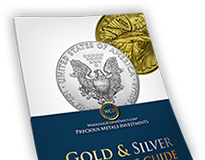- Gold $0.00 $0.00
- Silver $0.00 $0.00
- Platinum $0.00 $0.00
- Palladium $0.00 $0.00
Pricing:
| QUANTITY | E-CHECK/WIRE | CREDIT CARD |
|---|---|---|
| Any | $1,750.00 | $1,822.98 |

Get Our Free
Gold & Silver
Investor's
Guide
Description:
It was a decision that was to see millions of gold coins destroyed in an attempt by President Franklin D. Roosevelt to reinvigorate the U.S economy following the Great Crash of 1929. The country was in the throes of the Great Depression, the worst economic downturn in the history of the industrialized world, and Roosevelt wanted to galvanize recovery efforts. The date was April 5, 1933, and he had just signed Executive Order 6102, which made the "Hoarding of gold coin, gold bullion, and gold certificates" an offensive which could be punishable by both a hefty fine and a lengthy prison sentence. It was a decision which was to see millions of pre-1933 gold coins returned to the Treasury, where they would be melted. It was this act that makes examples of the $10 Indian Gold Eagle so sought after today.
It was another President Roosevelt, Theodore, who brought this distinctive coin into being, for he sought to produce coins for the American public that were beautiful and of high artistic merit. So he intervened to ensure that leading American sculptor Augustus Saint-Gaudens was commissioned to design new coins for the U.S. Mint. Though Saint-Gaudens' health quickly failed, his contribution was to have a lasting effect on American coinage, raising the standards of their artistry from that point onwards. The designs seen on the $10 Indian Gold Eagle, were originally intended for other coins but brought together, they make an enchanting combination and an exquisite coin.
The obverse design features a profile portrait of Liberty, believed to be based on the figure of Victory sculpted by Saint-Gaudens for his memorial to General William Tecumseh Sherman in New York's Grand Army Plaza, close to Central Park. However, there is one key difference; the subject is seen with an Indian headdress rather than one fashioned from laurel leaves. This may seem a surprising change, but it was one President Theodore Roosevelt insisted upon, for he felt the Indian headdresses were "distinctly American and very picturesque." In addition to this unique profile portrait of Liberty, you'll see 13 stars representing the original colonies of the United States curving around the top of the obverse design.
The reverse design is dominated by a bald eagle standing upon arrows representing America's ability to defend itself and an olive branch symbolizing that America is a peace-loving nation. The depiction of this eagle bears a striking resemblance to those coins of the ancient Ptolemaic Kingdom. The country of issue, the UNITED STATES OF AMERICA curves around the top of the design, while to the right of the Eagle is the phrase E PLURIBUS UNUM, taken from the great seal of the United States, meaning "Out of many, one." Below the standing bald eagle is the value of TEN DOLLARS.
The motto "IN GOD WE TRUST" was not originally included on the reverse side, however following public pressure; Congress passed a bill making use of the motto mandatory on all American coinage - so most surviving examples of the coin include this phrase. The design of this Indian Gold Eagle is completed with raised stars around the edge of the coin - here too there are variations between some years of issue. For from 1907 to 1911, the edge had 46 stars, representing the number of states of the Union at that time. However, two more stars were added to the edge in 1912, when Arizona and New Mexico became a part of the United States. Indian Gold Eagles have a weight of 16.72g and a diameter of 27mm, struck from .900 fine gold; they are composed of 90 percent gold and 10 percent copper.
The design for the $10 Indian Gold Eagle was not to be without controversy, and the obverse design, in particular, was derided for being historically inaccurate. What seemed to upset commentators most was the fact that a female figure was shown wearing a male headdress. It was deemed a "trifle fantastic." When it comes to mythical figures, when has historical accuracy been the gauge by which merit was measured? What is clear is that this exquisite coin breaks the mold of those coins that went before it, giving a fresh, contemporary feel to an American coin. From the clarity of the typography to the stylized modeling of Liberty, the $10 Indian Gold Eagle, has a crisp, streamlined look that had never before been seen on a U.S. coin. So snap up one of these stylish pieces today.
Coin Highlights:
- Minted in the year 1912
- US - San Francisco Mint
- AU50 graded by PCGS
- $10.00 Face Value
- 0.4838 oz of gold
Specifications:
| Product Type | Coin |
|---|---|
| Coin Series | Pre-33 Gold |
| Purity | 22 Karat |
| Mint/Refinery | U.S. Mint - San Francisco |
| Metal Type | Gold |
| Face Value | $10 |
| Grade | AU50 |
| Coin Type | Certified |
| Modern or Historical | Pre-33 |
| Grade Service | PCGS |
| Year | 1912 |
| Metal Weight | 0.4838 troy oz |





